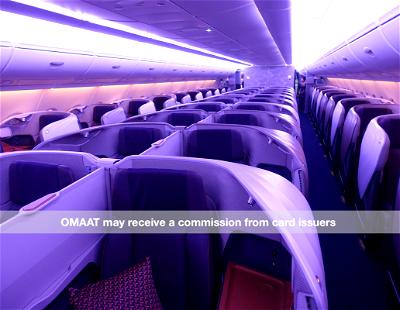Everyone takes a different approach to collecting miles & points. Some rack up points with a specific goal in mind, while others rack up points and almost view it as their retirement account, with no plans to redeem rewards anytime soon.
The issue, as we see all too often, is that loyalty programs tend to devalue over time. In this post I wanted to talk specifically about how you can best diversify your points and avoid devaluations, since this is an issue that many in the points hobby struggle with.
Below are some general thoughts on how to diversify your miles & points and avoid devaluations, in no particular order.
In this post:
Earn & burn, don’t view points as your retirement account
I think this is the single most important point I can make — whenever possible, always take an “earn & burn approach” to your points. All the time I hear from people who say “I’m earning points for retirement, and I look forward to redeeming them all then.”
Now, let me of course acknowledge that not everyone will always be in a position to redeem — maybe you can’t take time off work, or maybe there are other life circumstances. However, I absolutely can’t emphasize enough that I wouldn’t recommend viewing your points balance as a retirement account (well, unless you’re retiring shortly).
Why? Keeping points in an account in the long run is like keeping money in an account without accruing interest. It’s even worse than that, because odds are that your points currency has a higher inflation rate than most “real” currencies.
When you compare award redemption rates now to what they were a decade ago, in many cases you’ll find that award points requirements have gone up by over 100%.
Some might say “but I want to be able to travel when I retire.” That’s great, I’m all for that. The good news is that there are lots of opportunities to efficiently earn points, and those will (hopefully) still exist in retirement.
While points devalue over time, the great news is that it’s also easier to rack up points than ever before, in terms of how many points you can earn per dollar spent on credit cards, in terms of opportunities to buy points, etc.
So while the rewards you earned in the past are worth less now than they were then, there are still lots of amazing opportunities.

Earn transferable points whenever possible
While I do take an “earn & burn” approach, I will say that if I’m going to rack up points in the long-run, I always prefer for it to be transferable points currencies, whether those be points with Amex Membership Rewards, Capital One, Chase Ultimate Rewards, or Citi ThankYou.
Why do I feel more comfortable racking up transferable points without a short-term use?
- As the name suggest, the points can be transferred efficiently to various other airline and hotel programs, so you’re more shielded from devaluations than when earning points with a single program
- For several years now I’ve valued all major transferable points currencies at 1.7 cents each, unlike individual airline and hotel points currencies, where I’ve found the value to decrease over time; admittedly the same valuation doesn’t really help in keeping up with inflation, but it’s better than nothing
- Odds are that if you’re maximizing your travel credit card rewards, you’re earning one of these points currencies, so the points are also the easiest and most practical to rack up; this could be with cards like the Capital One Venture X Rewards Credit Card (review) (Rates & Fees), Chase Sapphire Preferred® Card (review), Citi Premier® Card (review), etc.

Shield yourself from devaluation with airlines & hotels
Admittedly many of us still earn points with specific airline and hotel loyalty programs. This can be through our natural travel patterns, because having a co-branded credit card makes sense, because we rack up points through third party activity, etc.
Of course I’m not opposed to collecting airline miles and hotel points, but I do make an effort to limit my balance in these programs at any given time. What are my considerations here?
- I try not to have more points in an individual account than I could realistically redeem for a couple of aspirational trips; that way if there is an advance notice of award pricing changes, I can book trips to get the most value from my points
- I try to focus on earning rewards with programs that can be trusted; this can include those that have a history of giving advance notice of pricing changes, and programs that publish award pricing, rather than having dynamic pricing (for example, programs like Air Canada Aeroplan and World of Hyatt)
- Be careful racking up points in a program that have a single award sweet spot; if that redemption is devalued, the whole reason you collected points may no longer apply (for example, redeeming Virgin Atlantic points on All Nippon Airways)

Be strategic about the points currencies you earn
There are so many huge credit card welcome bonuses out there nowadays, and it can be tempting to apply for just about all of them. The thing is, you still want to be strategic. Often I’ll hear from readers who have points balance with 10 different currencies, but don’t actually have enough points with any one program for it to be useful.
So, what’s the best way to handle this?
- The beauty of collecting transferable points is that they have many overlapping transfer partners, meaning that in many cases you could redeem Amex and Chase points toward the same redemption
- If you’re earning a specific airline or hotel points currency, I’d recommend having a general goal in mind, and then earning enough points to be able to redeem for that
You don’t want to be in a situation where you’re looking to visit Paris for five nights, and have 80,000 Hilton points, 30,000 Hyatt points, 100,000 IHG points, 40,000 Choice points, etc. (well, unless you want to change hotels every night).

Bottom line
Everyone’s strategy with miles & points will differ based on their own circumstances. In general, I highly recommend taking an earn & burn approach when accruing points, rather than viewing your rewards balance as a retirement account.
I try to mitigate the risk of any award program devaluations by accruing transferable points currencies whenever possible. If I am going to earn a specific airline or hotel points currency, I try to keep my points balance small enough so that I can redeem almost all of those points within several months in the event that there’s a devaluation.
What’s your strategy to diversifying points and minimizing the risk of points being devalued?





Agree with your points about having transferrable currencies. I think you do not mention a couple of points here. First, the benefits that some transferrable currency programs offer when redeeming with their travel center. Second, you don't discuss partner rewards when you fly for the flight. This means which airline in the group you would like the points to go to. Not all will issue partner rewards equally. The other thing you do not compare...
Agree with your points about having transferrable currencies. I think you do not mention a couple of points here. First, the benefits that some transferrable currency programs offer when redeeming with their travel center. Second, you don't discuss partner rewards when you fly for the flight. This means which airline in the group you would like the points to go to. Not all will issue partner rewards equally. The other thing you do not compare to is some of the cash back cards which could be lucrative for certain transactions. You also do not discuss avoiding having a small amount in many different accounts so you are unable to effectively use the points for anything.
Interestingly (and not to veer into Mr. Dunn's territory) the mileage currency which is least devaluation potential over the next 12 months is SkyMiles, simply because the value for partner premium redemptions has already devalued away and the remaining valuation case largely hinges on Pay With Miles. Since Pay With Miles is governed by the Amex cardholder agreement, not SkyMiles, it can't be taken away without, effectively, a year's notice.
Fundamentally, expecting outsize value in...
Interestingly (and not to veer into Mr. Dunn's territory) the mileage currency which is least devaluation potential over the next 12 months is SkyMiles, simply because the value for partner premium redemptions has already devalued away and the remaining valuation case largely hinges on Pay With Miles. Since Pay With Miles is governed by the Amex cardholder agreement, not SkyMiles, it can't be taken away without, effectively, a year's notice.
Fundamentally, expecting outsize value in one's redemptions is a bet that the airline you're flying on will price cash fares too high for supply/demand. That's somewhat less likely, given how much supply is off the market and will probably stay off the market for years to come (and things like 3/6 seat LH F cabins etc. won't help).
Even more interesting as the article recently discussed uses of Skymiles.
Since 2020, I just don't travel anymore. I have over 7 million points valued by award wallet at $107,000.00 I have at least a half-million points in each of the major airlines, hotels and credit card rewards (more than 14 different programs). I would gladly trade all the points and miles for the $107k award wallet cash valuation, but we all know that is not possible. I know the answer is bleak, but anyone with...
Since 2020, I just don't travel anymore. I have over 7 million points valued by award wallet at $107,000.00 I have at least a half-million points in each of the major airlines, hotels and credit card rewards (more than 14 different programs). I would gladly trade all the points and miles for the $107k award wallet cash valuation, but we all know that is not possible. I know the answer is bleak, but anyone with the keys to cashing out a dozen different programs for maximum $$$ value is welcome to surprise me. Though the $107k cash out is unattainable, I could generate at least $6k per year on that which would be enough for my dramatically reduced travel needs. "Cashing out" is on my mind, but the hassle and poor value are non-starters.
Because of the airport I try to keep AA and do my gaming of the system to maximize the points for some status. Its not much but it helps and makes life easier. I have let free night certificates expire. I have two hotel brands that I try to stay loyal to. I do have a savings account for points that I will use in about two years to go rtw
But didn't you just buy millions upon millions of AA points though :P ?
I have a pretty straightforward strategy for this hobby. SUB on 3 to 4 cards annually in 2-player mode. Typically focus transferable points for greatest flexibility, but occasionally pick up an odd AS or AA branded card.
I only transfer MR/C1/TY points to book premium award tickets on international long-haul flights and pay cash for economy on flights under 3,000 miles.
I transfer UR points solely to WoH for points reservations when valuation...
I have a pretty straightforward strategy for this hobby. SUB on 3 to 4 cards annually in 2-player mode. Typically focus transferable points for greatest flexibility, but occasionally pick up an odd AS or AA branded card.
I only transfer MR/C1/TY points to book premium award tickets on international long-haul flights and pay cash for economy on flights under 3,000 miles.
I transfer UR points solely to WoH for points reservations when valuation is more than 2.5 cents/point.
Should Chase Ultimate points be valued a bit higher than those from other major credit cards, taking into consideration the 25% (Preferred) to 50% (Reserve) boost in cash value when redeeming through their travel portal? I understand that the value of transferring points from any of these programs to their partners is about the same, but thought this bonus deserved a premium. I also understand that AMEX has a 35% points rebate for flights benefit,...
Should Chase Ultimate points be valued a bit higher than those from other major credit cards, taking into consideration the 25% (Preferred) to 50% (Reserve) boost in cash value when redeeming through their travel portal? I understand that the value of transferring points from any of these programs to their partners is about the same, but thought this bonus deserved a premium. I also understand that AMEX has a 35% points rebate for flights benefit, but that's only for their business Platinum.
I think you should consider the point values, too. The same ticket with Amex rewards travel center is probably a lot more Amex points than Chase points through the Chase system. Chase is also more reasonable for the rate when you combine cash and points. Chase has more airline options through their center.
I’m past the aspirational travel phase . I plan on using all my AA miles within the next 9 months on BA awards 57.5k or 85k +$700 per ticket. I’m confident there will be no devaluation that soon.
Big changes are coming Ben. Beyond our worst nightmare so this article is spot on. Look back 8 yrs and see where we were . How do you think rewards programs and redemptions are looking 8 yrs from now ?
A few interesting implications here...
1) If people are saying they want to travel when they retire - aren't cashback cards, or using cards like Amex Schwab, and establishing a "travel fund" the best way to go? Over 20-30 years, this can be a powerful strategy to build a travel piggy bank (combined with general saving).
2) Your point about earning enough points to have meaningful balances resonates with me. But often you can earn...
A few interesting implications here...
1) If people are saying they want to travel when they retire - aren't cashback cards, or using cards like Amex Schwab, and establishing a "travel fund" the best way to go? Over 20-30 years, this can be a powerful strategy to build a travel piggy bank (combined with general saving).
2) Your point about earning enough points to have meaningful balances resonates with me. But often you can earn more transferrable points by spending on co-brand cards. For example, an American Airlines flyer may need to augment his/her flying with spending on an AA Cobrand card if he/she wants to build up points fast. Does this suggest that spending on cobrand cards have a place when you are augmenting earned miles? You almost never recommend spending on cobrand cards.
To point #1, I think the implication is that if your plan is to save for traveling at some distant time (i.e. 5 or more years from now), you're better off saving money the old fashioned way, less so about a specific saving strategy within the umbrella of points. The points & miles game is just that: a game. By no means am I an expert, but I have personally been playing long enough to...
To point #1, I think the implication is that if your plan is to save for traveling at some distant time (i.e. 5 or more years from now), you're better off saving money the old fashioned way, less so about a specific saving strategy within the umbrella of points. The points & miles game is just that: a game. By no means am I an expert, but I have personally been playing long enough to get some sweet redemptions and get burned on devaluations. The terms & conditions of each point system makes it clear that there is no inherent value (or the inherent value is defined in the same way those paper coupons are worth 1/100th of a penny). It's a game of keeping ahead of the banks, and if you can't devote the time or energy, you shouldn't play.
If travel is a long-term goal where you need to have the money available, then you're better off with securities (that is savings accounts, stocks, and bonds). In the same way that no credible financial adviser would tell you to speculate on Bitcoin or options if you need that money, Ben is telling us to that this is not how to save money for the future.
Your point 2 resonates with me when you reside in a hub captive area like DFW. And when AA really has no meaningful transfer partner, you spend AA miles and you may find yourself in a tight spot. Even Citi or Barclay AA Advantage cards have no real earning power. Nothing like Amex or Chase with multiples. As a retired couple with a decent stash of AA miles, we still don't even think of spending...
Your point 2 resonates with me when you reside in a hub captive area like DFW. And when AA really has no meaningful transfer partner, you spend AA miles and you may find yourself in a tight spot. Even Citi or Barclay AA Advantage cards have no real earning power. Nothing like Amex or Chase with multiples. As a retired couple with a decent stash of AA miles, we still don't even think of spending them like international. We basically use domestic as how do you replace AA miles? Oh card SUBs long gone plus 4 years between churning.
Hi Harry,
If I’m understanding you right, it seems like you’re saying that you use your AA miles for domestic flights rather than international bc you don’t want to spend down a balance that is hard to build up.
If that’s the case, have you considered AA one world partners (like British Airways) to cover those domestic flights? The redemptions are often cheaper that way and it’s easier to build a balance of...
Hi Harry,
If I’m understanding you right, it seems like you’re saying that you use your AA miles for domestic flights rather than international bc you don’t want to spend down a balance that is hard to build up.
If that’s the case, have you considered AA one world partners (like British Airways) to cover those domestic flights? The redemptions are often cheaper that way and it’s easier to build a balance of BA points through transferable currencies.
Then you could use your AA points for international sweet spots (e.g., business class on Japan airlines) that would be hard to get otherwise.
Regardless, using one world partners to cover your domestic AA flights is one way that you could use transferable points to slow down the usage of your hard earned AA miles
You can buy them anytime.
Cobranded credit cards are almost never a good deal unless charging that merchant, so points will not be earned quickly. For most other purchases pure bank credit cards or travel rewards credit cards offer a better deal. These transferrable currencies could also be pushed to major airlines.